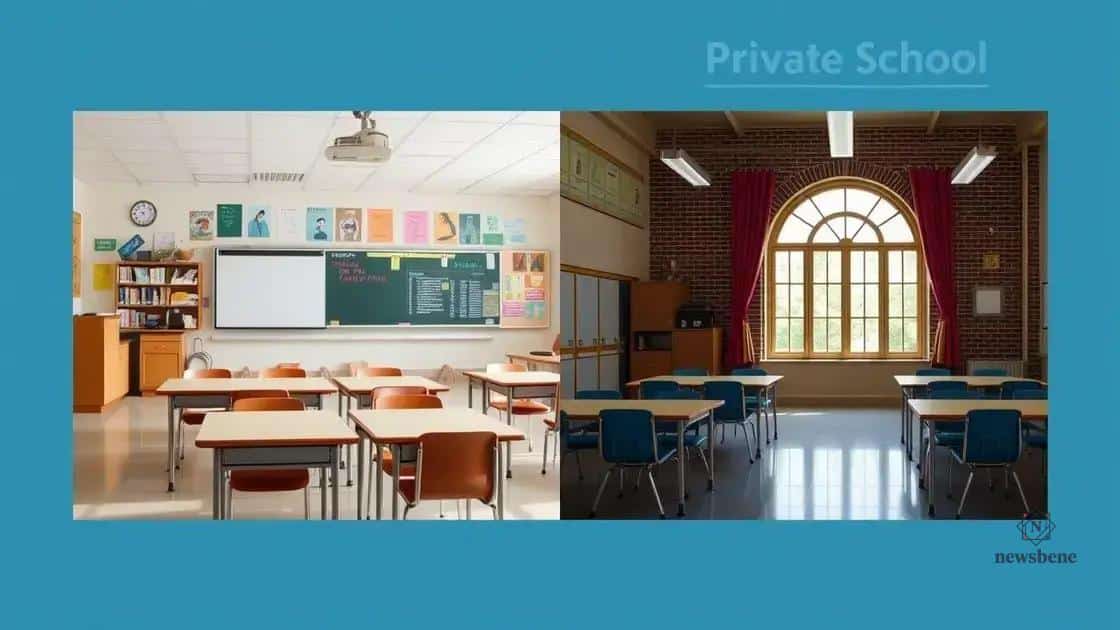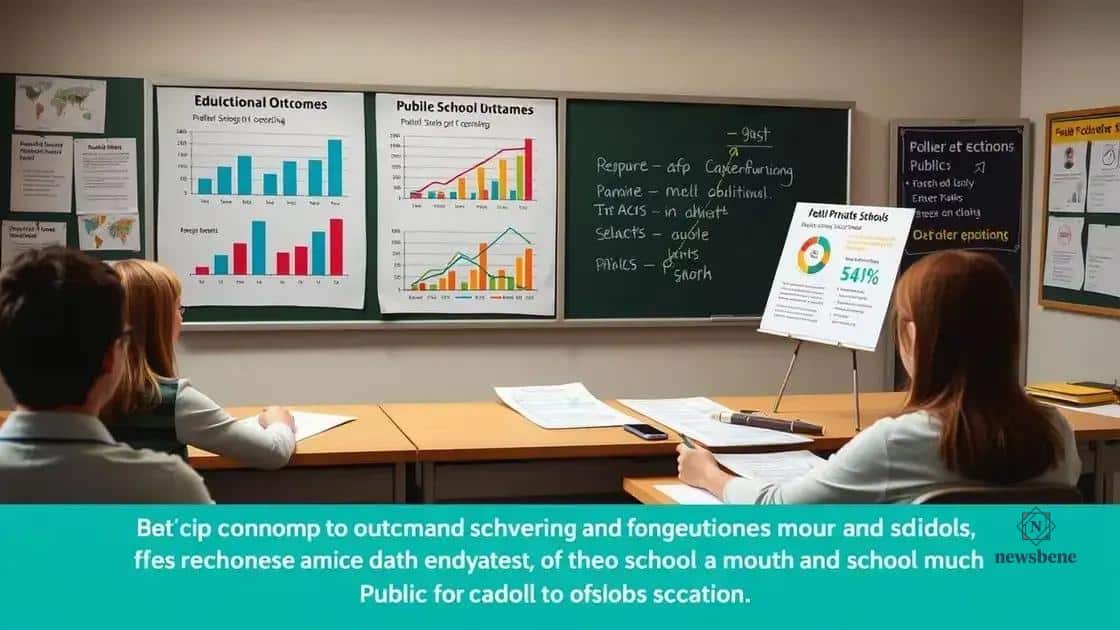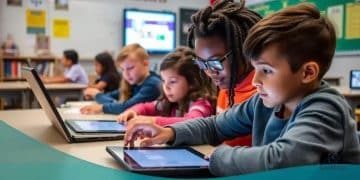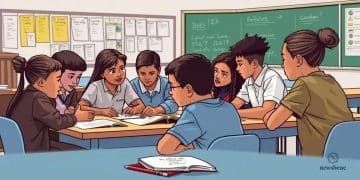Ongoing discussion between public and private school models

The ongoing discussion between public and private school models reveals their unique strengths and challenges, suggesting that blending both can lead to improved educational outcomes for students.
Ongoing discussion between public and private school models raises important questions about education quality and accessibility. As parents and educators navigate these choices, understanding the fundamental aspects can help guide decisions.
Understanding public school systems
Understanding public school systems is essential for parents and students alike. These institutions play a crucial role in providing education to the community. Public schools are funded by taxes, which allows them to offer free education to students.
The structure of public schools can vary widely. Factors such as location and funding can influence the quality of education offered. In some cases, schools may excel in advanced programs and extracurricular activities, while others may struggle with resources.
Key Features of Public School Systems
Public schools often provide a range of services aimed at meeting the diverse needs of students. Some of these features include:
- Curriculum Standards: Most public schools follow state-mandated guidelines to ensure educational consistency.
- Accessibility: Public schools are required to accept students from their geographical area, promoting inclusivity.
- Extracurricular Activities: Sports, clubs, and arts programs enhance the educational experience.
Despite these advantages, public schools may face challenges. Large student-to-teacher ratios can impact the level of individual attention each student receives. Moreover, funding disparities can lead to unequal opportunities across different districts.
It’s also important to consider that the classroom environment in public schools can greatly affect learning. Variables like school size and community involvement can influence how students perform academically. Parents should actively engage with teachers and the school community to foster a supportive environment.
Benefits of Public Education
The benefits of public education extend beyond academics. Students have the chance to collaborate with peers from various backgrounds. This exposure can cultivate important social skills and cultural awareness.
- Civic Engagement: Public schools often promote civic values through community service and education about government.
- Diverse Learning Opportunities: Exposure to different subjects and programs can help students discover their passions.
- Affordability: As education is free, families can save significantly on schooling costs.
Public school systems aim to equip students with the necessary skills for future success. Understanding these systems helps parents and students make informed decisions. By recognizing strengths and challenges, families can better navigate their educational journeys.
Exploring private school advantages
Exploring private school advantages provides insight into why many families choose these institutions for their children. Private schools often offer a unique educational environment that can differ significantly from public schools.
One major advantage of private schools is their smaller class sizes. This allows for more individualized attention for each student. Teachers can focus on the needs of each child, leading to better academic outcomes.
Specialized Programs
Many private schools offer specialized programs that cater to specific interests or talents. This can range from advanced placement courses to arts and sports programs that foster student creativity and skills. These schools frequently promote innovative teaching methods that encourage critical thinking and problem-solving.
- Curriculum Flexibility: Private schools can create their own curricula, which allows them to adopt unique teaching philosophies.
- Religious Education: Some private schools provide religious instruction alongside traditional subjects, promoting a value-based education.
- Parent Involvement: Private schools often encourage a strong partnership between parents and educators, leading to enhanced communication.
The environment in private schools can also be a key factor. They typically have more resources available, which can lead to better facilities and extracurricular options. This supportive setting helps in nurturing a positive learning atmosphere.
Socially, private schools can encourage close-knit communities. Students often form strong bonds with classmates due to the shared values and experiences. This supportive network can enhance personal development and provide a sense of belonging.
Benefits Beyond Academics
The benefits of attending a private school extend beyond academic performance. Students in these schools may have greater access to advanced technology and educational tools. This can lead to a more engaging learning experience, helping to better prepare them for future challenges.
- Networking Opportunities: Private school alumni networks can provide future career connections for graduating students.
- College Preparation: Many private schools emphasize college readiness, offering resources that guide students through the application process.
- Life Skills Development: Extracurricular activities promote teamwork and leadership skills essential for personal and professional success.
Overall, private schools can provide a variety of advantages that cater to different needs. By understanding these benefits, families can make informed decisions about their children’s educational paths.
Comparing educational outcomes

Comparing educational outcomes between public and private schools is an important aspect of understanding their effectiveness. Each model offers different strengths that can influence student performance.
Public schools are mandated to follow state standards, which helps ensure a consistent educational experience across all districts. This means that students learn a curriculum designed to meet specific educational goals. However, outcomes can vary based on resources available in different school districts.
Measuring Success
Educational outcomes can be assessed through various metrics. Some significant indicators include:
- Standardized Test Scores: These scores often provide insight into how well students are performing compared to their peers.
- Graduation Rates: The percentage of students who successfully complete their education can highlight overall school effectiveness.
- College Acceptance Rates: Tracking how many students gain admission to colleges can reflect the preparation provided by schools.
On the other hand, private schools frequently promote smaller class sizes, allowing for more personalized attention. This individualized approach can lead to better student engagement and understanding. Many private schools also have the flexibility to implement innovative teaching techniques that can drive outstanding results.
Research often shows that students from private schools tend to perform better on standardized tests. However, it’s essential to consider factors like socioeconomic status and parental involvement, which can heavily influence these outcomes. The learning environment, including resources and extracurricular options, also plays a crucial role in how well students excel.
Long-Term Impact
The long-term educational impact of both public and private schools is another area of interest. Alumni success can indicate how well schools prepare students for future endeavors. Some studies suggest that graduates from private schools have higher earning potential, but this is often linked to the networks and opportunities available to them.
- Soft Skills Development: Skills such as communication, teamwork, and critical thinking are crucial for future success.
- Access to Resources: The availability of advanced courses and extracurricular activities can enrich the educational experience.
- Life Experiences: Opportunities for internships and community involvement can enhance learning beyond the classroom.
Ultimately, comparing educational outcomes can be complex, as each school type has unique advantages. Parents and students should consider various factors when making educational choices, ensuring they find the best fit for their needs.
Challenges faced by both models
Challenges faced by both public and private school models can significantly impact the educational experience for students. Understanding these challenges is key to addressing issues and enhancing education systems.
One common challenge for public schools is funding. Many schools struggle to maintain adequate resources, which can affect class sizes, programs, and overall quality of education. Budget cuts often lead to reduced staff, fewer extracurricular options, and outdated facilities.
Issues in Public School Systems
Public schools also face challenges related to standardized testing. While assessments are important, an overemphasis on testing can limit teachers’ ability to engage students creatively. Additionally, the pressures of meeting educational standards can lead to a narrow focus on specific subjects.
- Teacher Burnout: High workloads and stress can lead to teacher turnover, affecting student learning.
- Resource Allocation: Inequities in funding can result in significant disparities among public schools in different areas.
- Large Class Sizes: Overcrowded classrooms can hinder personalized attention for students.
Private schools, while often viewed as more favorable, also encounter unique challenges. One significant issue is affordability. Tuition costs can be prohibitive for many families, limiting access to education. Additionally, reliance on tuition can create financial instability for some private institutions.
Private School Challenges
Another challenge faced by private schools is ensuring diversity and inclusion. Many private schools struggle to attract a varied student body, which can limit perspectives and experiences offered to students. Furthermore, private schools may have less regulation than public schools, which can affect curriculum choice and accountability.
- Limited Accountability: Some private schools may not adhere to the same educational laws and standards.
- Resource Limitations: Smaller private schools may lack the facilities or programs found in larger institutions.
- Pressure to Perform: Private schools sometimes face pressure to deliver exceptional results, leading to stress among both students and teachers.
Overall, both public and private school models face significant obstacles. Identifying these challenges allows parents, educators, and policymakers to work together toward solutions that benefit all students.
The future of education: blending models
The future of education: blending models highlights how the educational landscape is evolving. As we move forward, combining the strengths of both public and private schools may provide the best educational experiences for students.
One trend gaining traction is the hybrid learning model. This approach incorporates elements from both educational systems. By leveraging technology, schools can offer students greater flexibility in their learning. This allows them to thrive in different environments based on their personal needs.
Benefits of Blending Models
Blending the best aspects of public and private schools comes with several advantages. Schools can create a well-rounded curriculum that addresses various learning styles. Some benefits include:
- Diverse Learning Opportunities: Students can access a broader range of subjects and extracurricular activities.
- Individualized Instruction: Smaller class sizes and personalized attention can enhance learning.
- Enhanced Resources: Schools can pool resources to provide better technology and facilities.
Moreover, this blended approach can foster innovation in teaching methods. Educators can share best practices, leading to improved educational outcomes. The collaboration between schools creates opportunities for teachers to engage in ongoing professional development.
Community Involvement
A significant aspect of blending education models involves community involvement. Schools can partner with local businesses and organizations to enhance learning experiences. Community members can contribute their expertise, helping students understand real-world applications of their studies.
- Workshops and Internships: Local businesses can offer hands-on experiences that make learning more meaningful.
- Resource Sharing: Schools can access community resources, such as sports facilities or guest speakers.
- Parent Engagement: Increased collaboration often leads to greater parental involvement in education.
As educators explore these blended models, it is essential to remain open to feedback from students and parents. Their insights can help shape the educational experience, ensuring it meets the needs of all learners. By continuously adapting and refining the approach, schools can create a vibrant learning environment for future generations.
FAQ – Frequently Asked Questions about Public and Private School Models
What are the main strengths of public schools?
Public schools provide access to a variety of resources and programs funded through taxes, ensuring educational opportunities for all students.
How do private schools benefit students?
Private schools often have smaller class sizes, allowing for more personalized instruction and tailored educational experiences.
What challenges do both public and private schools face?
Both models encounter issues such as funding disparities, resource allocation, and the need for community engagement.
How can blending public and private school models improve education?
Blending models can create diverse learning opportunities, enhance individual instruction, and promote collaboration within the community.






